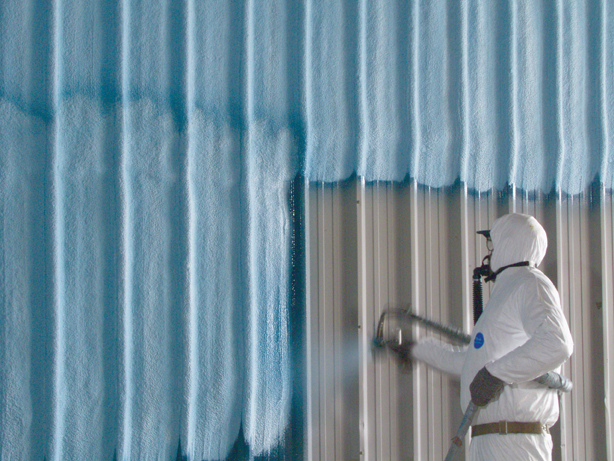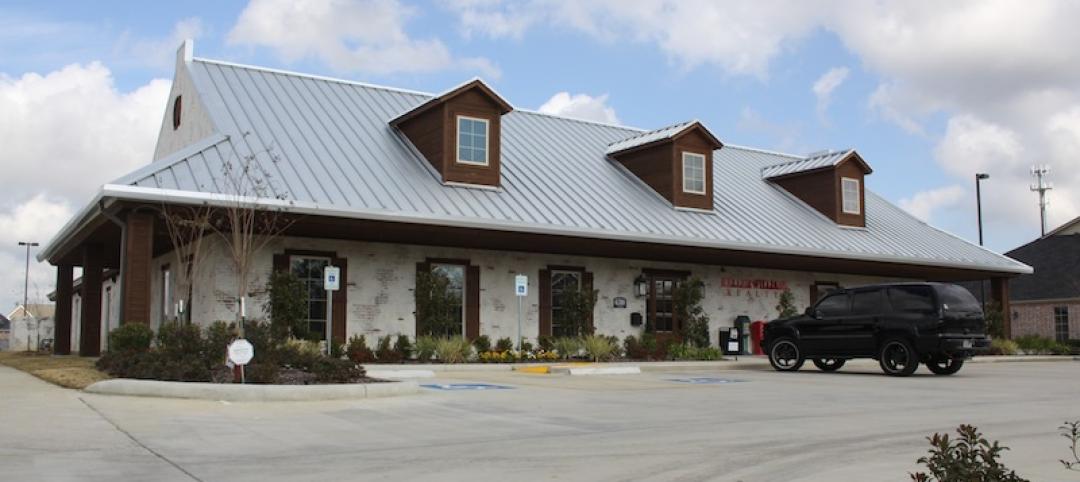In the nonresidential sector, spray polyurethane foam (SPF) has been used most often for re-roofing existing buildings. While SPF is hardly a new product (it’s been around for at least 35 years), the applications for both open-cell and closed-cell foam have been growing steadily as Building Teams grasp its potential to improve energy efficiency, interior comfort and durability in all types of structures.
Demand for SPF is increasing in both new construction and retrofit applications in North America, says Brian Troy, commercial market manager for Icynene. “On the new construction side, the increase can be quantified by the sheer number of new specifications coming out every day, calling for SPF within the published construction documents,” he says.
LEED certification is also pushing more architects, contractors, and developers to use spray foam in the walls and building envelope as well as on the roof, says Michael Sievers, business manager for spray polyurethane foams at BASF Corp. That’s because SPF has multiple attributes, notably air sealing, thermal performance, and structural performance. “Instead of being a niche product, it’s becoming more of a mainstream product,” says Sievers.
The introduction of renewable-based SPF products that reduce the need for petroleum-based polyols has probably had the most significant impact on commercial applications, as architects, designers and building owners look for additional opportunities toward total point contributions on LEED-registered projects. This is especially true for government facilities that must comply with mandates for energy efficiency. “Spray foam is 25-30% more energy efficient because it’s seamless and monolithic, so it’s often used in building retrofits,” says Rick Tucker, global business manager for Honeywell’s TerraStrong, a closed-cell SPF.
Because spray foam is often 10-15% more expensive than other types of insulation, it’s sometimes used in combination with products such as rigid board insulation in order to achieve higher R-values. “If you want R-20 or R-30, you can use board stock on the exterior and foam on the interior,” says Tucker. “It’s an effective way to reduce or eliminate thermal bridging.”
Let’s take a look at some recent projects where Building Teams—and their clients—benefited from using SPF.
THE SEARCH FOR ‘ULTRA-INSULATION’
For the New Century International Elementary School in Cumberland County, N.C., SfL+a Architects, Raleigh, N.C., wanted the project to be more than just another LEED Platinum building: They wanted it to serve as a model for future buildings that will save their owners millions of dollars in the long term. The school is designed for net-zero energy use, meaning that it will generate more energy than it consumes. Among the sustainable features is a closed-loop geothermal HVAC system, solar panels that will generate electricity and heat water, controlled lighting systems, and NCFI’s InsulBloc spray foam insulation for the building envelope.
“We wanted ultra-insulation, air and vapor barriers in a single product,” says Robert W. Ferris, AIA, REFP, LEED AP, CEO and president of SfL+A. “With board insulation, there are a lot of joints that have to be taped to prevent water from entering. Foam eliminates all the joints. The primary benefits are increased R-values and decreased infiltration losses, and we get a nice waterproofing over our block.”
EXTRA : Spray Foam Insulation Trends |
At 175-185 Wyman Street, a new corporate campus in Waltham, Mass., Columbia Construction Co., North Reading, Mass., used NCFI’s InsulBloc for the first time in conjunction with a terra cotta rainscreen system. The project consists of two buildings with a variety of exterior surfaces, including metal, terra cotta, and precast concrete. The owner is seeking LEED Gold certification.
“Moisture can get in behind the terra cotta wall panels, but it drains out at the bottom,” explains Sam Dettore, a senior project manager with Columbia. “The spray-on insulation, which becomes inert—a block of insulation behind that terra cotta—is preferable because it’s resistant to any kind of moisture that might get into the wall.”
Dettore says two different methods were used to apply the NCFI product. For the metal exteriors, foam was sprayed onto an air and vapor barrier and the metal panels were installed over that. Sanford Contracting, North Billerica, Mass., prefabricated the wall panels for the terra cotta exteriors. “Sanford assembled the walls and applied the foam and terra cotta in their warehouse, then delivered the panels to the job site and hung them in place on the steel superstructure of the building,” says Dettore.
A recent inspection by Columbia Construction showed that InsulBloc is living up to expectations. “We’ve gone through an entire cycle of weather that you can have in New England, and it’s resisted any kind of cracking or twisting,” says Dettore.
MORE DEMAND FOR LOW-PRESSURE FOAM
In commercial buildings, contractors use high-pressure foam—sprayed out of a rig at more than 1,000 psi—to create a monolithic exterior insulation layer. But low-pressure foam also has its uses in commercial construction, says Tom Fishback, vice president of R&D for Fomo Products, whose spray foam is dispensed from portable kits at 200 psi.
“Probably the greatest demand for low-pressure spray foam in commercial buildings, both new construction and retrofit, is at the roof/wall juncture,” says Fishback. “That juncture is often not air-sealed. Even in new buildings, the usual practice is to stuff fiberglass insulation into the cavity in a non-fire-rated wall. The width of that gap can be six inches, and it allows cold air and pollutants to come through from outside.”
Fishback says some contractors have started sealing roof/wall junctures with Fomo’s low-pressure foam, dispensing it to a depth of two inches. He says this results in an R-value of 12.
The retrofit market is another strong one for low-pressure foam. In New York City, for example, old factories and warehouses are being converted to loft condominiums and the exterior cladding of old public schools is being stripped off and replaced. Low-pressure foam has proven very effective in sealing the gaps between windows and walls. Those gaps, which can be up to four inches wide, are one of the greatest ingress points for moisture and air, Fishback says. Applying a Class A, two-component spray foam to the gaps gives the insulation an R-value of 6.2 per inch.
One more benefit of spray foam insulation: acoustics. SPF has proven to be an effective sound barrier in office conference rooms where noisy presentations or webcasts may take place. “There’s a lot of noise emanating from those rooms to adjacent offices,” says Fishback. “Open-cell foam is very easy to apply, and it creates a good monolithic layer on interior walls.”
Related Stories
| Jan 13, 2014
Custom exterior fabricator A. Zahner unveils free façade design software for architects
The web-based tool uses the company's factory floor like "a massive rapid prototype machine,” allowing designers to manipulate designs on the fly based on cost and other factors, according to CEO/President Bill Zahner.
| Jan 7, 2014
Concrete solutions: 9 innovations for a construction essential
BD+C editors offer a roundup of new products and case studies that represent the latest breakthroughs in concrete technology.
| Jan 6, 2014
An interview with Jerry Yudelson, President, The Green Building Initiative
Green building consultant Jerry Yudelson has been named President of the Green Building Initiative and the Green Globes rating program. BD+C's Robert Cassidy talks with Yudelson about his appointment and the future of Green Globes.
| Dec 18, 2013
Firestone Building Products acquires Spain-based Terrassa in global expansion
Firestone has announced that it has agreed to acquire the manufacturing assets and brands of Terrassa, Spain-based Giscosa and Giscolene®. The acquisition of the Giscosa Ethylene Propylene Diene Monomer (EPDM) plant near Barcelona expands Firestone’s global manufacturing and distribution capabilities and product offering.
| Dec 16, 2013
Is the metal building industry in a technology shift?
Automation is the future you can’t avoid, though you may try. Even within the metal building industry—which is made up of skilled tradesmen—automation has revolutionized, and will continue revolutionizing, how we work.
| Dec 10, 2013
16 great solutions for architects, engineers, and contractors
From a crowd-funded smart shovel to a why-didn’t-someone-do-this-sooner scheme for managing traffic in public restrooms, these ideas are noteworthy for creative problem-solving. Here are some of the most intriguing innovations the BD+C community has brought to our attention this year.
| Nov 27, 2013
Wonder walls: 13 choices for the building envelope
BD+C editors present a roundup of the latest technologies and applications in exterior wall systems, from a tapered metal wall installation in Oklahoma to a textured precast concrete solution in North Carolina.
| Nov 27, 2013
University reconstruction projects: The 5 keys to success
This AIA CES Discovery course discusses the environmental, economic, and market pressures affecting facility planning for universities and colleges, and outlines current approaches to renovations for critical academic spaces.
| Nov 22, 2013
Health Product Declaration Collaborative to develop protocol for third-party verification of HPDs
Seven leading product sustainability assessment companies partner with the HPD Collaborative to develop the verification and quality assurance protocols.















